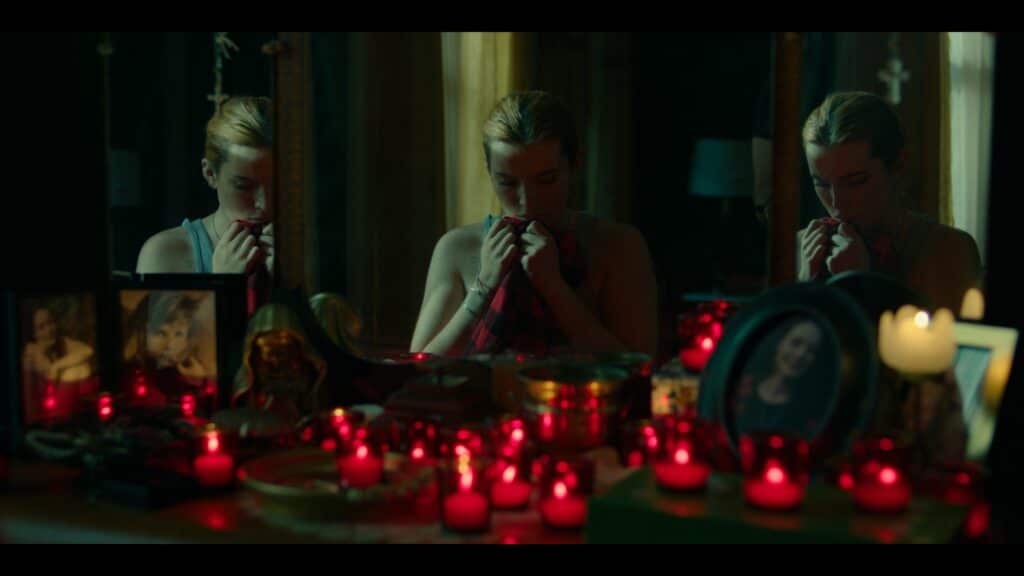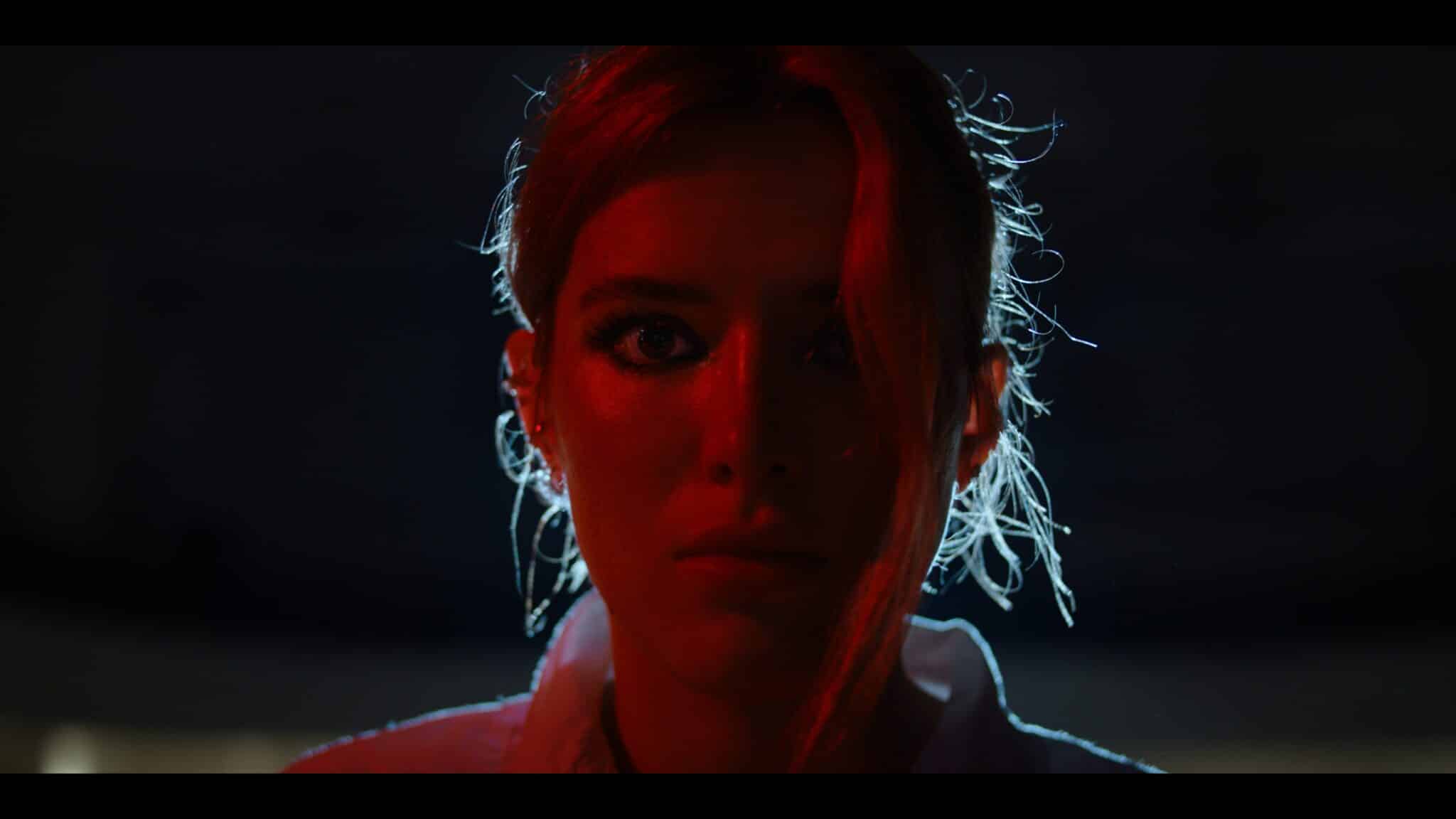
“Everything I have said and done has been in the hands of God”: a young woman, lying on her bed, intones this sentence over and over, like a mantra, as Saint Clare (2024) begins. This is apparently a Joan of Arc quotation, but it’s hopefully no spoiler to point that Joan figures but little in this film. Instead, Saint Clare comes off like a piece of young adult fiction brought to the screen (okay), but it is blended rather unconvincingly with a much darker subtext, even if largely through implication and suggestion. The tone is off. The film is more of a mystery than a horror, so the horror content which does feature may feel a little thin or derivative for the majority of viewers. It’s a visually very impressive film, but there are issues at hand.
The bedroom mantra-chanter is in fact our ‘Saint’ Clare (Belle Thorne), who has recently moved towns to live with her hippy grandma (a criminally-underused Rebecca De Mornay) after some recent personal tragedies sent her into a cycle of moving house, sofa hopping and boarding schools. But she has recently arrived in town, and seems to be settling well at what I think is also meant to be another school, despite Ms. Thorne herself being nearly 27. Or, hey, maybe it’s college. Whatever, the American tradition of casting older adults as young adults (or even children) is a long, noble one by this point – even with an Italian director. The setting is what counts.
But wherever Clare is being educated, all is not well with her. As she sits and waits for a bus after school/college one afternoon, she is intercepted by a clearly creepy man in a car who comes out with a daft excuse for her to get into his vehicle. If it seems a little strange that this clearly savvy girl, who asks him all the right questions, does in fact decide to get in is explained shortly afterwards, when she attacks and kills him. She is – and this is never particularly explored – a kind of vigilante, who gets visions of wrong ‘uns, and knows to dispatch them for the greater good.
Another facet of Clare’s strangeness is her occasional interaction with the ghost of a man who, although not a sex criminal – as in inferred in the other cases – did die as a result of an interaction with Clare: this would be Bob (Frank Whaley), who was once a mailman, and he appears here and there to either act as Clare’s conscience, or to offer plot-expedient details which move things along. All of this would be strange enough, but successfully killing criminals and sometimes chatting to a dead mailman probably wouldn’t make for a narrative arc, so we need something else: this comes in the form of a discovery.
It turns out that the man she recently killed was not acting alone, which could mean that Clare is at risk from those people who worked with him, if they find out who she is. The case also prompts an investigation, with police interviews taking place. Along the way, as Clare takes it more and more upon herself to find out what’s been going on in this town, she finds concrete evidence of a misogynistic conspiracy, reaching back for years. Now it’s her destiny to solve the mystery, putting herself at renewed risk as she does.
So there is some kind of movement and development here, but Saint Clare remains a simple story. It glosses over some of its potentially finer plot points – such as fully accounting for Clare’s supernatural abilities – and its determination to keep the camera fixed on Thorne at all costs means that it but rarely scans around for anything else to consider. Other characters are left resolutely one-dimensional, and male characters aren’t exactly characters at all: in places, they’re little more than caricatures, and Saint Clare‘s universe is certainly not kind to men more generally.
But for balance, let’s consider its treatment of its key protagonist: that’s not rich or detailed, either. People tell Clare that she is ‘hot’ and ‘pretty’, if ‘weird’: fair enough, but things don’t get much deeper than that. Clare is pretty but weird; no one tells her she’s complex. She gets through a series of unfortunate events with a pout-scowl and a monotone drawl which don’t really reflect the peril she’s meant to be in. Elsewhere, her peers provide some light relief, bringing the teen girl drama and petty rivalries (though it’s not abundantly clear whether we are meant to be laughing at them, or with them). Light relief dissipates by the time of the final act, though in its place comes frustration that the narrative gets increasingly scrappy, dodging clear answers. No one is strongly drawn enough to get us fully invested.
Nonetheless, there are strengths, and lots of the film’s key strengths relate to its strong production values and visuals. It’s an aesthetically very bold film, which highlights peril through its roving camerawork, close shots and choppy edits. The ‘fade to red’ motif is a simple, but appealing addition; director Mitzi Peirone goes quite heavy on the flashback and backfill, which, whilst not always adding that complexity, does nonetheless make for a more varied viewing experience, with artistic shot composition and a great accompanying soundtrack. To sum up, for some viewers this reasonably light-touch mystery will do enough to entertain, thanks to its star appeal and an aesthetic flair which carries well across (nearly) ninety minutes. For others, this reviewer included, the film alludes too much and explores too little, namechecking the notion of whole, complex, liberated female film characters but teasing us by not really including any.
Saint Clare (2024) received its UK Premiere at FrightFest 2024 and will be released on digital from 101 Films (date TBC).
